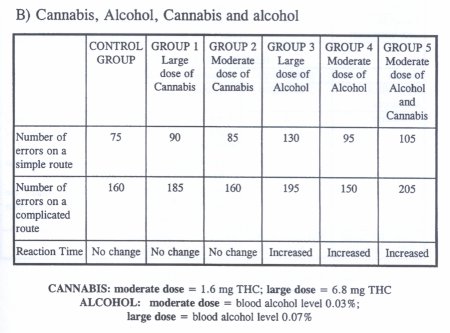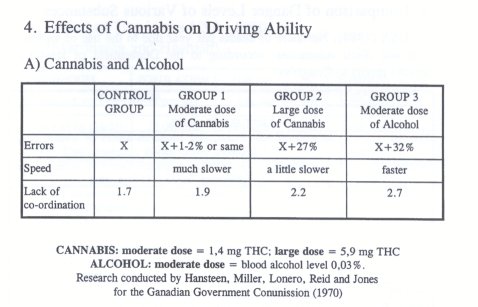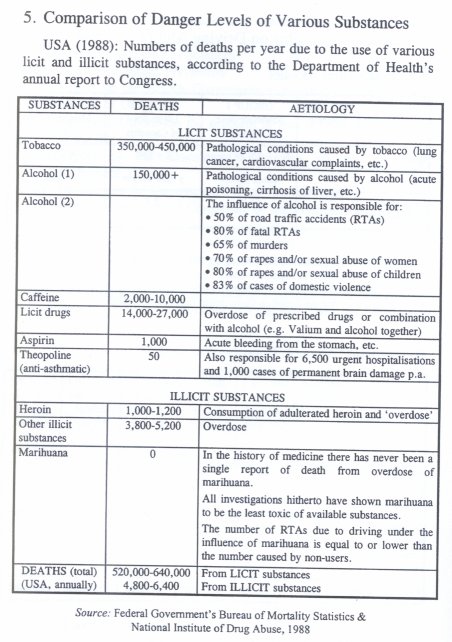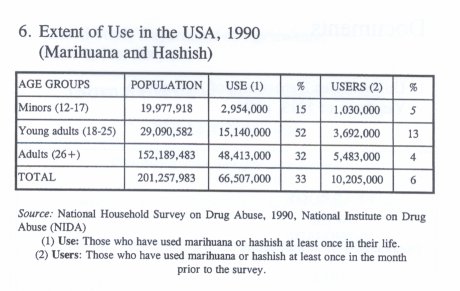Tables
| Books - Cannabis: Marihuana - Hashish |
Drug Abuse
Tables
Species
Cannabis
Varieties
Cannabis sativa, Cannabis indica, Cannabis ruderalis
Description
Dioecious plant, self-sown and cultivated
Active ingredients
1) Δ9-Tetrahydrocannabinol orΔ9-THC
2) Δ8-Tetrahydrocannabinol orΔ8-THC
Δ9-THC
The main active ingredient of cannabis. Heavily concentrated in the flower-bearing parts of the plant. Indissoluble in water, soluble in organic solvents. With the passage of time it oxidises and becomesΔ6-THC.
Concentration of Δ9-THC: In marihuana: 0.5-4% (usual content: 1-2%). In hashish: 8-15% (usual content: 10%)
Derivatives
1) MARIHUANA: mixture of all parts of the cannabis plant (flowers, leaves, stems), which are dried, chopped, and smoked. Green in colour.
2) HASHISH: tablets of unprocessed resin produced by the sepals when compressed under heat. Dark in colour.
3) HEMPSEED OIL: thick, viscous substance extracted from the sepals using ethyl alcohol, which subsequently evaporates.
Therapeutic applications
1. Endophthalmic hypertension (glaucoma)
2. Side-effects of chemotherapy
3. Asthma
4. Depression and anorexia
5. Pain of varying aetiology
6. Epilepsy and spasms
7. Dependence on alcohol and opiates
8. Various neoplasias
THC preparations
1. Dronabinol (marketed as Marinol)
2. Nabilone (marketed as Cesamet)
3. Reports of Official Commissions
1894 United Kingdom: The Indian Hemp Drugs Commission Report Report of the Indian Hemp Drugs Commission
1924 United Kingdom: Addiction (Rolleston Committee's Report) Report of the Departmental Committee on Drug Addiction
1944 United States: La Guardia Report Report of the New York Mayor's Committee on `The Marihuana Problem in the City of New York'
1961 United Kingdom: Drug Addiction First Report of the Interdepartmental Committee.
1964 United Kingdom: Drug Addiction (Brain Committee's Report) Second Report of the Interdepartmental Committee.
1968 United Kingdom: Cannabis (Wootton Committee's Report) Report of the British Government's Advisory Committee on Drug Dependence
1970 Canada: Interim Report (Le Dain Report) Report of the Canadian Government's Commission of Inquiry into Non-Medical Use of Drugs
1971 United States: Marihuana and Health Report of the US Department of Health, Education, and Welfare (First Annual Report to the Congress).
1972 United States: Marihuana and Health Report of the US Department of Health, Education, and Welfare (Second Annual Report to the Congress).
1972 The Netherlands: Report Report of The Netherlands Government's Commission on Drugs
1972 Canada: Cannabis Report of the Canadian Government's Commission of Inquiry into Non-Medical Use of Drugs
1972 United States: Marihuana: A Signal of Misunderstanding (Nixon Report) Report of the US National Commission on Marihuana and Drug Abuse.
1972 United States: Licit and Illicit Drugs(265) Report of the US Consumers' Union
1973 United States: Marihuana and Health Report of the US Department of Health, Education, and Welfare (Third Annual Report to the Congress)
1974 United States: Marihuana and Health Report of the US Department of Health, Education, and Welfare (Fourth Annual Report to the Congress)
1973 United States: Drug Abuse in America: Problem in Perspective Report of the US National Commission on Marihuana and Drug Abuse
1974 United States: Eastland Report Report of the US Senate's Commission on Drugs(266)
1976 Australia: On Drugs Report of the Australian Government's Advisory Committee on Drugs(267)
1977 United States: Chronic Cannabis Use Report of the New York Academy of Sciences
1977 United States: The Marihuana Issue: Report from NORML Report by the US Drug Abuse Council
1982 United Kingdom: Treatment and Rehabilitation Report of the British Government's Advisory Council on the Misuse of Drugs
1982 United States: Marihuana and Health: Evaluation of Past Studies National Academy of Sciences
1982 United Kingdom: Prevention Report of the British Government's Advisory Council on the Misuse of Drugs
1986 European Union: On the problem of narcotics in the countries of the EU Report of the Examining Committee of the European Parliament.
1986 Greece: On the Government's Draft Law on Drugs Report of the Special Committee of the Medical Association of Thessaloniki
1988 United Kingdom: AIDS and Drug Misuse Report of the British Government's Advisory Council on the Misuse of Drugs
1992 European Union: On the spread of organized crime in the EU Report of the Examining Committee of the European Parliament
ALL THESE REPORTS AGREE THAT CANNABIS:
1) does not lead to dependence;
2) has no negative biological effects when used in moderation; even when abused, however, its effects are far less serious than those of alcohol or tobacco;
3) has no aetiological connection with the use of addictive substances; it is not a preliminary stage to the use of addictive substances and the `escalation theory' is consequently untenable;
4) is not a factor in crime.

265 E. Brecher, Licit and Illicit Drugs (1972).
267 Drug Survival News (Jan.-Feb. 1978) and The Journal (April 1978).
| < Prev | Next > |
|---|















